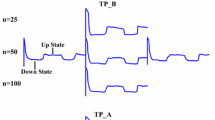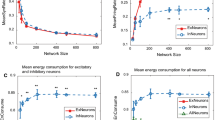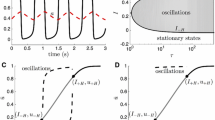Abstract
Up and down transitions are found to be a significant spontaneous brain activity which was first found in slow wave sleep. We studied on a neural network model of spontaneous up and down transitions with two types of neurons, namely excitatory and inhibitory neurons (INs). On the basis of the model, we found ionic currents play a leading role in up and down transitions and then discussed neurodynamics of these transitions influenced by the ionic channel parameters. Through the observation and analysis of these results, we are trying to explain the dynamics of up and down transitions and to reveal the role of these transitions in cortex activities.
Access provided by Autonomous University of Puebla. Download conference paper PDF
Similar content being viewed by others
Keywords
1 Introduction
Spontaneous periodic up and down transitions are considered to be a significant phenomenon of brain activities. This slow oscillation characterized by large delta waves predominates the electroencephalogram (EEG). Neural electrophysiology experiments also show that during slow wave sleep in the primary visual cortex of anesthetized animals [1–3] and during quiet wakefulness in the somatosensory cortex of unanesthetized animals [4], the membrane potentials make spontaneous transitions between two different levels called up and down states [5]. These two states show the bistability of the membrane potentials.
Why these transitions occur and whether this spontaneous activity engages in brain functions or not still remains unclear. In fact, we know little about expressions of neuron membrane potentials and interactions between neural networks, especially the relationship between neural coding modes and cognitive behaviors. In earlier researches, the hyperpolarizations activated inward current has been implicated in the pacemaking of both single cell and network rhythmicity [6–8]. Other results indicate that the dynamic interplay between the gating and kinetic properties of \( I_{\text{h}} \) and \( I_{\text{NaP}} \) is essential for the generation of rhythmic subthreshold oscillations by the stellate cells [9].
Our former study on the up and down transitions of a single neuron [10] and a small network with constant connection [11] had been trying to explain the dynamic mechanism from ionic channel level. Furthermore, in this paper, we expanded the model by clarifying the neurons to two types, namely excitatory neurons (ENs) and inhibitory neurons (INs) and redefining the changing connecting function between two neurons instead of constant connection, so that the model is closer to the physiological reality than before. Then, we continued to explore the reason which influence on the spontaneous periodic up and down transitions and how they impact on.
2 Biophysical Model
In this paper, we modeled the two types of neurons, ENs and INs, with two kinds of currents, the ionic currents [12] and synaptic currents mediated by AMPA, NMDA, and GABAA receptors.
For the ENs,
For the INs,
The ionic currents are:
where, \( m_{\infty } = \left( {1 + \mathop {\exp }\nolimits^{{ - \frac{{V - T_{m} }}{{\sigma_{m} }}}} } \right)^{ - 1} ,h_{\infty } = \left( {1 + \mathop {\exp }\nolimits^{{\frac{{V - T_{h} }}{{\sigma_{h} }}}} } \right)^{ - 1} \), \( \tau_{h} = \frac{1}{\alpha + \beta } \), \( \alpha = \frac{{a_{\alpha } V + b_{\alpha } }}{{1 - \mathop {\exp }\nolimits^{{ - \frac{{V + b_{\alpha } /a_{\alpha } }}{{k_{\alpha } }}}} }} \), \( \beta = \frac{{a_{\beta } V + b_{\beta } }}{{1 - \mathop {\exp }\nolimits^{{ - \frac{{V + b_{\beta } /a_{\beta } }}{{k_{\beta } }}}} }} \), \( b_{\infty } = \left( {1 + \mathop {\exp }\nolimits^{{ - \frac{{V - T_{b} }}{{\sigma_{b} }}}} } \right)^{ - 1} \), \( \tau_{b} = \tau_{b}^{0} \cdot {\text{sech}}\;\left( {\frac{{V - T_{b} }}{{4\sigma_{b} }}} \right). \)
The synaptic currents are:
where, the stationary relationship between the transmitter concentration \( [T] \) and presynaptic voltage is fit to \( [T] = T_{\hbox{max} } /\left( {\left( {1 + \exp^{{ - \frac{{V - V_{p} }}{{K_{p} }}}} } \right)} \right) \)[13]. The slow part of the NMDA synaptic receptor is \( f_{\text{NMDA}} = 1/\left( {\left( {1 + \exp^{{ - \frac{{V - T_{f} }}{{\sigma_{f} }}}} } \right)} \right) \)[14].
3 Simulation Results
In the above model, there were four kinds of ionic currents: an instantaneous, inward current (sodium current), a slow h-like current, two outward currents (a potassium current and a leak current). And we wanted to make sure how these currents influence on the spontaneous up and down transitions. In the ionic level, the ion channel property and condition may be the point. So we tested different cases of different channels in different conductance conditions in Fig. 103.1.
All the plots in Fig. 103.1 were the average membrane potentials of the network in various levels of conductances. The left column was the cases in different potassium conductances, the center column was the cases of potassium conductance, and the right column was the cases of conductance of h-like channel. If the potassium channel was in an appropriate range, the average membrane potential demonstrated spontaneous up and down transitions with bistability. And the bigger potassium conductance, the fewer transitions, and the shorter duration of the up state. Furthermore, if the potassium conductance was excessively activated, the membrane potential always kept in down state. Conversely, when it was insufficiently activated, membrane potential was in up state. This was cohere with the results of our previous work [10, 11]. On the other hand, in the situations of sodium channel and h channel, reversely to the potassium channel, the results presented that bigger potassium conductance, the more transitions and the longer duration of the up state.
Furthermore, the results of quantitative analysis were illustrated in Fig. 103.2. Besides the up state duration of the membrane potential (top row), we also studied the cycle of the transitions (middle row) and the ratio of up state in the cycle (bottom row) of three kinds of channels, potassium channel (left column), sodium channel (center column), and h channel (right column). The main tendency was that the up state duration increases with the potassium conductance decreasing and the sodium conductance and conductance of h channel increasing, during appropriate ranges in which the membrane potential shows up as down transitions. However, the cycle of the transitions were not changing so much in most conditions except the cases in which the membrane potential was near but not approach to the lasting down states. The up state ratio in the cycles showed the similar tendency with the situation of up state duration.
In view of ionic channel, the mechanism of up and down transitions can be briefly described as follows. Depolarization activates the sodium channel letting the sodium ions move into cells, then the potassium channel was activated slowly making the potassium ions move out of the cells which leads to the result of hyperpolarization. And the hyerpolarization then activates the h channel which allows sodium and potassium ions [15] going through. Base on this point, the ionic channel interpretation for Figs. 103.1 and 103.2 would be obviously. The bigger value of potassium conductance makes the faster movement of potassium ions going out of the cells, leading to shorter up state duration. While, the smaller value of sodium conductance gives rise to much more sodium ions moving into the cells which results in longer up state duration. As to the conductance of h channel, the results were similar with the case of sodium conductance. Therefore, we tended to believe that the sodium ions largely contribute to the h-like current.
4 Discussion
This paper mainly discussed about the dynamics of up and down transitions on ionic level, using the network model showing spontaneous transitions. We found the opening degree of the ionic channels had responsibility for the up and down transitions, especially the up state duration.
Specially, the more opening degree of potassium channel, the shorter up state duration. Extremely, the much bigger of potassium conductance led to lasting down state, and the much smaller one resulted in lasting up state. However, the sodium and h channels held the opposite results that the more opening of channels, the longer up state durations. And considering about the extreme cases, the much bigger conductances brought about lasting up state and the much smaller ones gave rise to lasting down state. And the similarity function of sodium channel and h -channel indicated that sodium ions largely contribute to the h-like current though it involves in a mixture of sodium and potassium ions.
According to these results, we are trying to explain the dynamics of up and down transitions from the view of ionic channel. It is helpful to reveal the role of these transitions in network behaviors as well as to lay the foundation of knowing neural dynamic mechanism of cortex activities.
References
Anderson, J., Lampl, I., Reichova, I., Carandini, M., Ferster, D.: Stimulus dependence of two-state fluctuations of membrane potential in cat visual cortex. Nat. Neurosci. 3(6), 617–621 (2000)
Lampl, I., Reichova, I., Ferster, D.: Synchronous membrane potential fluctuations in neurons of the cat visual cortex. Neuron 22(2), 361–374 (1999)
Steriade, M., Nunez, A., Amzica, F.: Intracellular analysis of relations between the slow (<1 hz) neocortical oscillation and other sleep rhythms of the electroencephalogram. J. Neurosci. 13(8), 3266–3283 (1993)
Petersen, C.C., Hahn, T.T., Mehta, M., Grinvald, A., Sakmann, B.: Interaction of sensory responses with spontaneous depolarization in layer 2/3 barrel cortex. Proc. Natl. Acad. Sci. 100(23), 13638–13643 (2003)
Parga, N., Abbott, L.F.: Network model of spontaneous activity exhibiting synchronous transitions between up and down states. Front. Neurosci. 1(1), 57 (2007)
DiFrancesco, D.: Pacemaker mechanisms in cardiac tissue. Annu. Rev. Physiol. 55(1), 455–472 (1993)
Lüthi, A., McCormick, D.A.: H-current: properties of a neuronal and network pacemaker. Neuron. 21(1), 9–12 (1998)
Pape, H.C.: Queer current and pacemaker: the hyperpolarization-activated cation current in neurons. Annu. Rev. Physiol. 58(1), 299–327 (1996)
Dickson, C.T., Magistretti, J., Shalinsky, M.H., Fransen, E., Hasselmo, M.E., Alonso, A.: Properties and role of Ih in the pacing of subthreshold oscillations in entorhinal cortex layer II neurons. Methods. 1996(1998), (1998)
Xu, X., Wang, R.: Neurodynamics of up and down transitions in a single neuron. Cogn. Neurodyn. 8(6), 509–515 (2014)
Xu, X., Wang, R.: Neurodynamics of up and down transitions in network model. Abstr. Appl. Anal. 2013 (2013)
Loewenstein, Y., Mahon, S., Chadderton, P., Kitamura, K., Sompolinsky, H., Yarom, Y., Häusser, M.: Bistability of cerebellar purkinje cells modulated by sensory stimulation. Nat. Neurosci. 8(2), 202–211 (2005)
Koch, C.,Segev, I.: Methods in Neuronal Modeling: From Ions to Networks. MITpress, Cambridge (1998)
Destexhe, A., Mainen, Z.F., Sejnowski, T.J.: Synthesis of models for excitable membranes, synaptic transmission and neuromodulation using a common kinetic formalism. J. Comput. Neurosci. 1(3), 195–230 (1994)
Ermentrout, G.B., Terman, D.H.: Mathematical Foundations of Neuroscience. Springer, Berlin (2010)
Author information
Authors and Affiliations
Corresponding author
Editor information
Editors and Affiliations
Rights and permissions
Copyright information
© 2016 Springer Science+Business Media Singapore
About this paper
Cite this paper
Xu, X., Wang, R. (2016). Neurodynamics of Up and Down Transitions Influenced by Ionic Channel Parameters. In: Wang, R., Pan, X. (eds) Advances in Cognitive Neurodynamics (V). Advances in Cognitive Neurodynamics. Springer, Singapore. https://doi.org/10.1007/978-981-10-0207-6_103
Download citation
DOI: https://doi.org/10.1007/978-981-10-0207-6_103
Published:
Publisher Name: Springer, Singapore
Print ISBN: 978-981-10-0205-2
Online ISBN: 978-981-10-0207-6
eBook Packages: Biomedical and Life SciencesBiomedical and Life Sciences (R0)






